The AMD Trinity Review (A10-4600M): A New Hope
by Jarred Walton on May 15, 2012 12:00 AM ESTAMD Trinity General Performance
Starting as usual with our general performance assessment, we’ve got several Futuremark benchmarks along with Cinebench and x264 HD encoding. The latter two focus specifically on stressing the CPU while PCMarks will cover most areas of system performance (including a large emphasis on storage) and 3DMarks will give us a hint at graphics performance. First up, PCMark 7 and Vantage:
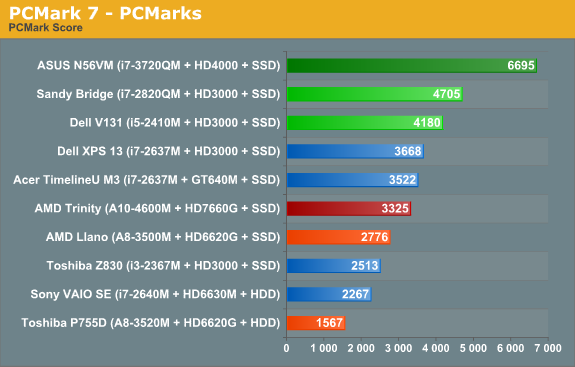
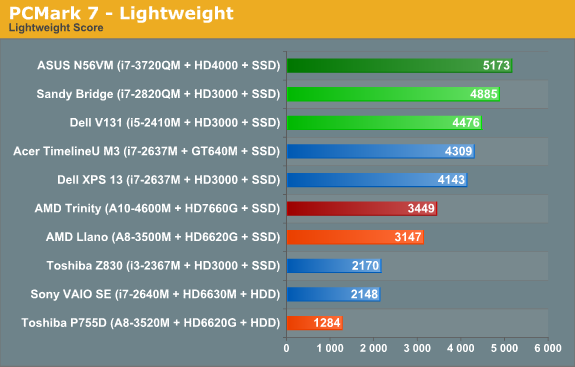
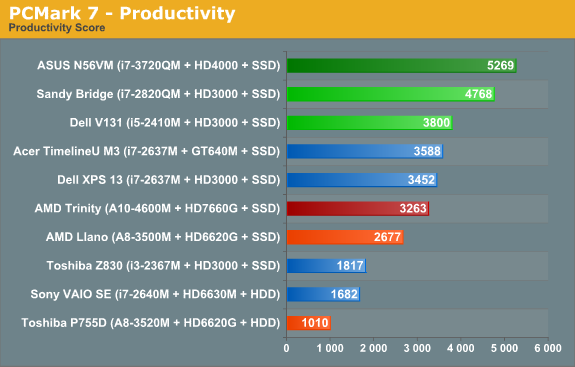

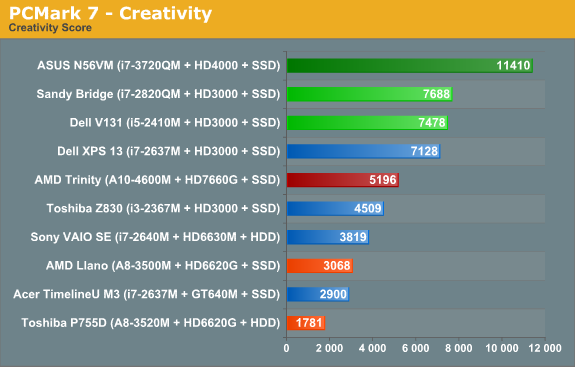
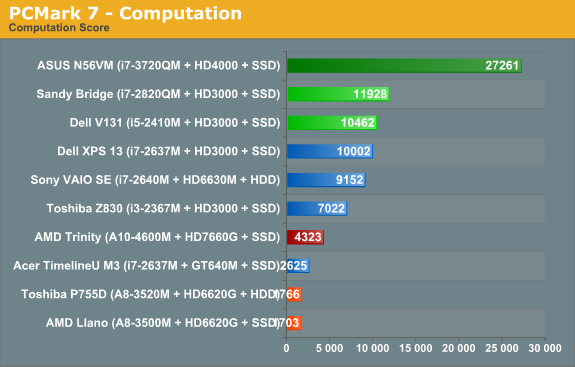
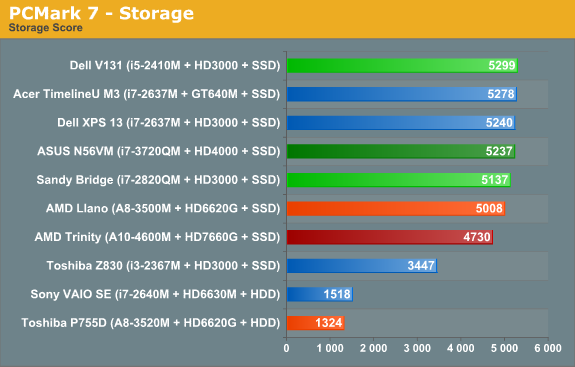
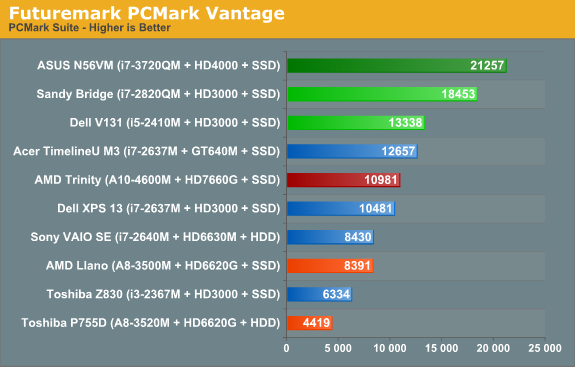
As noted earlier, we ran several other laptops through PCMark 7 and PCMark Vantage testing using the same Intel 520 240GB SSD, plus all the ultrabooks come with SSDs. That removes the SSD as a factor from most of the PCMark comparisons, leaving the rest of the platform to sink or swim on its own. And just how does AMD Trinity do here? Honestly, it’s not too bad, despite positioning within the charts.
Obviously, Intel’s quad-core Ivy Bridge is a beast when it comes to performance, but it’s a 45W beast that costs over $300 just for the CPU. We’ll have to wait for dual-core Ivy Bridge to see exactly how Intel’s latest stacks up against AMD, but if you remember the Llano vs. Sandy Bridge comparisons it looks like we’re in for more of the same. Intel continues to offer superior CPU performance, and even their Sandy Bridge ULV processors can often surpass Llano and Trinity. In the overall PCMark 7 metric, Trinity ends up being 20% faster than a Llano A8-3500M laptop, while Intel’s midrange i5-2410M posts a similar 25% lead on Trinity. Outside of the SSD, we’d expect Trinity and the Vostro V131 to both sell for around $600 as equipped.
A 25% lead for Intel is pretty big, but what you don’t necessarily get from the charts is that for many users, it just doesn’t matter. I know plenty of people using older Core 2 Duo (and even a few Core Duo!) laptops, and for general office tasks and Internet surfing they’re fine. Llano was already faster in general use than Core 2 Duo and Athlon X2 class hardware, and it delivered great battery life. Trinity boosts performance and [spoiler alert!] battery life, so it’s a net win. If you’re looking for a mobile workstation or something to do some hardcore gaming, Trinity won’t cut it—you’d want a quad-core Intel CPU for the former, and something with a discrete GPU for the latter—but for everything else, we’re in the very broad category known as “good enough”.


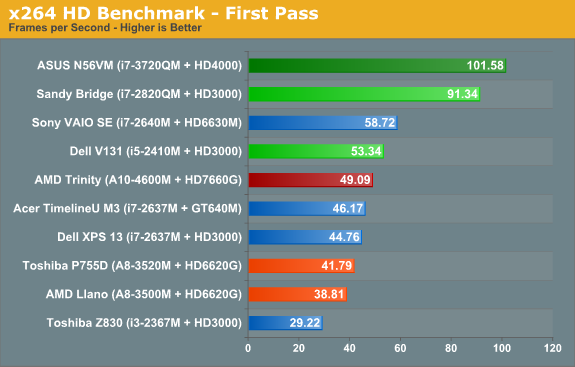
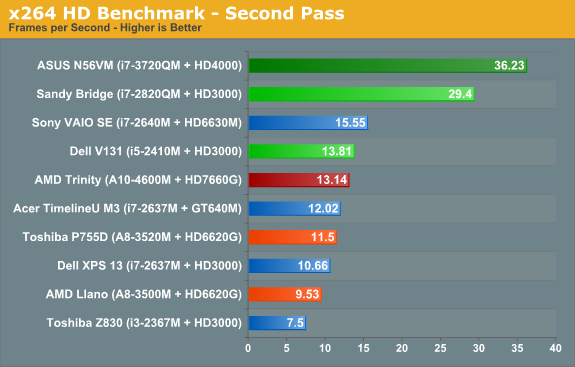
When we start drilling down into other performance metrics, AMD’s CPU performance deficiency becomes pretty obvious. The Cinebench single-threaded score is up 15% from 35W Llano, but in a bit of a surprise the multi-threaded score is basically a wash. Turn to the x264 HD encoding test however and Trinity once again shows a decent 15% improvement over Llano. Against Sandy Bridge and Ivy Bridge, though? AMD’s Trinity doesn’t stand a chance: i5-2410M is 50% faster in single-threaded Cinebench, 27% faster in multi-threaded, and 5-10% faster in x264. It’s a good thing 99.99% of laptop users never actually run applications like Cinebench for “real work”, but if you want to do video encoding a 10% increase can be very noticeable.

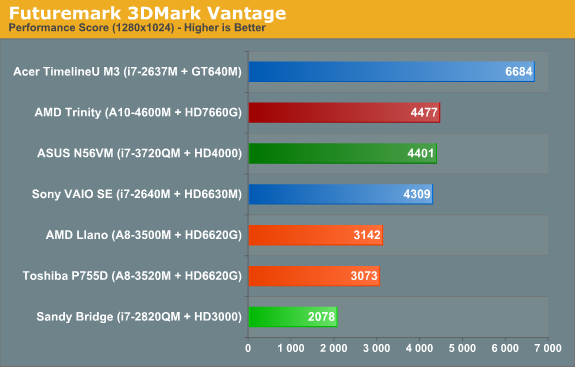
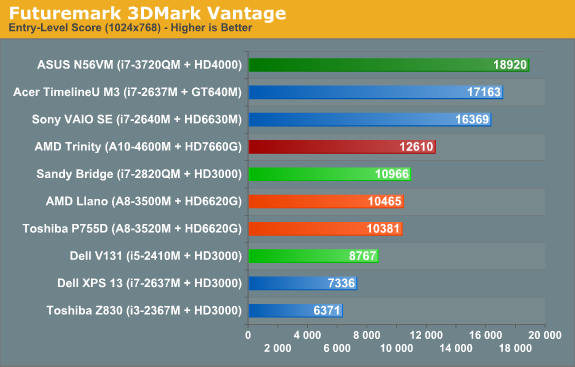
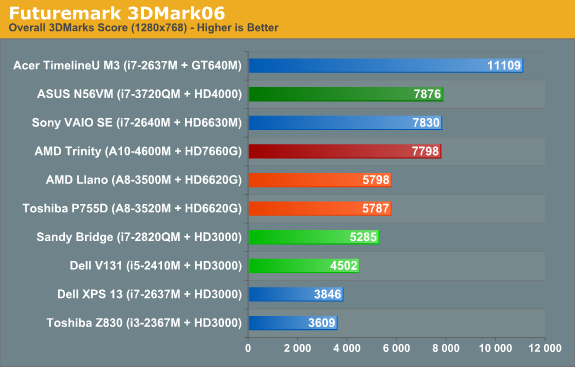
Shift over to graphics oriented benchmarks and the tables turn once again...sort of. Sandy Bridge can’t run 3DMark11, since it only has a DX10 class GPU, but in Vantage Performance and 3DMark06 Trinity is more than twice as fast as HD 3000. Of course, Ivy Bridge’s HD 4000 is the new Intel IGP Sheriff around these parts, and interestingly we see Trinity and i7-3720QM basically tied in these two synthetics. (We’ll just ignore 3DMark Vantage’s Entry benchmark, as it’s so light on graphics quality that we’ve found it doesn’t really stress most GPUs much—even low-end GPUs like HD 3000 score quite well.) We’ll dig into graphics performance more with our gaming benchmarks next.










271 Comments
View All Comments
zepi - Tuesday, May 15, 2012 - link
You've got it backwards.Stuff is priced according to the value it has for customers. To get as much money from their product as possible, regardless of manufacturing costs. Or that's what everybody is aiming for. Trinity is going to be cheap only because it's not good enough to get sales if priced higher.
Best possible outcome for everybody would have been that cheapest Trinity-based laptops would cost about $1500, but they'd be about as fast as Ivy Bridge Quadcore-desktops with Geforce GTX680 and still achieve a battery-life of about 8min per Wh. And performance & price would both have only gone upwards from there on.
That kind of performance-dominance would force Intel and Nvidia to drop their prices considerably (getting us the cheap laptops regardless of trinity being pricey) and we'd still have to option to go for über Trinity's if we'd have the cash.
And it would save AMD from bankruptcy, ensuring that we'd have competition in future as well.
Llano, Brazos and Bulldozer are all horrible products for AMD. Good product is characterized by the fact, that it has considerably more worth to the customer than it costs to manufacture it. If a product is good, it's easy to price it accordingly, and people will still buy it. AMD's CPU's are apparently very bad products, because AMD is making huge losses at the moment. And I don't think it's the GPU-division that's causing those losses.
JarredWalton - Tuesday, May 15, 2012 - link
Products are priced according to where the marketing folks think they'll sell. All you have to do is walk into Best Buy and talk to a sales person to realize that they'll push whatever they can on you, even if it's not faster/better. And I think the bean counters feel they can sell Trinity at $700 or more--and for many people, they're probably right. We'll see $600 and $500 Trinity as well, but that will be the A8 and A6 models, with less RAM and smaller HDDs.As far as competition, propping up an inferior product in the hope of having more competition isn't healthy, and if AMD has a superior product they simply charge as much as Intel. NVIDIA is the same. If someone came out with a chip that had the CPU performance of IVB and the GPU performance of a GTX card, all while using the power of Brazos...well, you can bet they'd charge an arm and a leg for it. They wouldn't sell it for $1500, they'd sell it for $2500--and some people would buy it.
Ultimately, they're all big businesses, and they (try to) do what's best for the business, so I buy whatever product fits my needs best. I wish Trinity were more impressive, particularly on the CPU side of the equation. I think if Trinity's CPU were as fast as Ivy Bridge, the GPU portion would probably end up being 50% faster than HD 4000; unfortunately, there are titles that require more CPU work (Skyrim for instance) and that starts to level the playing field. But wishing for something that isn't here, or playing the "what if" game, just doesn't really accomplish anything.
Targon - Wednesday, May 16, 2012 - link
And you can get a quad-core A6 laptop for under $500 right now. If you pay attention, you generally get what you pay for. For most users, going with an AMD quad-core laptop does provide a decent product for the price. For some, CPU power is more important, and for others, a more well rounded machine is more important. I expect that A10-4600 laptops will start closer to $600 than $700, unless you are looking at machines with a large screen, discrete graphics, or something else that increases the prices.CeriseCogburn - Wednesday, May 23, 2012 - link
What you're all missing is all the then second tier Optimus laptops that will have much deflated pricing, as well as the load of $599 amd discrete laptops that will sell like wildfire and please those who waited - just like the amd fans are constantly waiting for nVidia to release so they can snag a second tier deflated price amd card.Since the "cpu doesn't matter !" as we have been told, there's no excuse to not snag a fine and cheap Optimus that won't have an IB.
This is the "best time in the world" for all the amd fans to forget all prior generations of laptops and pretend, quite unlike in the video card area, that nothing else exists.
I love how amd fans do that crap.
evolucion8 - Tuesday, May 15, 2012 - link
Also remember that Penryn was launched on 2007-2008 and until late 2009, several Core 2 Duo laptops were released. I have a Gateway MD7309u and it was launched on October 2009 and still feeling very snappy and has good battery life, I hate its GMA 4500M with my whole heart.....Nfarce - Tuesday, May 15, 2012 - link
Yeah well I don't understand the point of buying a low-mid range laptop expecting to be enjoying playing games at basic laptop 1366x768 resolutions. What's the point?You can spend around $1,200 on a mid-range i5 turbo boost laptop with a discreet GPU and 1600x900 resolution screen that plays games decently without completely shutting down the eye candy sliders. Save up and get a better laptop - and Intel with a dedicated AMD or Nvidia GPU. If you can afford $600 now, you can afford $1,200 down the road and enjoy things much better.
CeriseCogburn - Wednesday, May 23, 2012 - link
I agree but the famdboy loves to torture itself and claim everyone else loves cheap frustrating crap - often characterized as a "mobile employee on the road, in the airplane, or at the hotel spot" needing a "game fix"...(in other words someone flush enough to buy +discrete) as you pointed out.The rest of the tremendous and greatly pleased "light gamers" will purportedly be playing at work( no scratch that) or on their couch at home (that sounds like the crew) ... and then one has to ask why aren't they using one of the desktops at home for gaming... a $100 vidcard in that will smoke the crap out of "the light gamer".
That leaves "enthusiasts" who just want to play with it and see for a few minutes if they can OC it, and "how it does" with games... and after that they will want to throw it at a wall for how badly it sucks - not to mention their online multi-player avatar will get smoked so badly their stats will plummet... so that will last all of two days.
So we get down to who this thing is really good for - and I suppose that's the young teen to pre teen brat - as a way to get the kid off mommy's or daddy's system so they can have the reigns uninterrupted... so the teeny bopper gets the crud low $ cheap walmart lappy system that should also keep them tamed since being too rough with it means the thing snaps in half a the plastic crumbles.
Yep - there it is - teeny bopper punkster will just have to live with the jaggied pixelized low end no eye candy crawler - and why not they still love it much more than homework and have no problem eyeballing the screen.
Latzara - Tuesday, May 15, 2012 - link
While i agree with the 'nothing earthshattering' part I have to wonder what kind of average Internet browsing usage are you commenting on when you say 'People want their laptop to be responsive when doing work, watching movies and browsing' -- Most of the CPUs on the entire board presented here are enough for work - not graphics modelling mind you - excell, DB, mail, presentations, average calculation load, and even smaller programming projects - which constitutes most of the workload an average worker is gonna get, movies stopped being an issue way before, and what kind of browsing are we talking about that will make your platform unresponsive (i don't mean frozen)? 25 tabs at once? Cause i've done that with a much weaker platform and had no issues...The main problem i see is that the plaform hasn't moved as much as ppl hoped, but enough to be a new iteration in terms of progress - and with the right pricing it could be the sweet spot for many of the broader average consumers - not just the '1% of the 1% of people looking for great gaming" ...
BSMonitor - Tuesday, May 15, 2012 - link
Load up a couple Java runtime environments in those browsers. Some flash. I did have an etc in there. I am a multi-tasker, and cannot stand waiting any amount of time. For the majority of real laptop owners, a late Pentium M, Athlon 64/X2, is not enough power for any real work.Spunjji - Wednesday, May 16, 2012 - link
Please define a "real" laptop owner? I own an Alienware and I don't do any of that sort of crap. Mind you, most users I have met express more patience than you do, too. regardless, in none of these metrics do you appear to represent the majority, which is the target market for this chip.